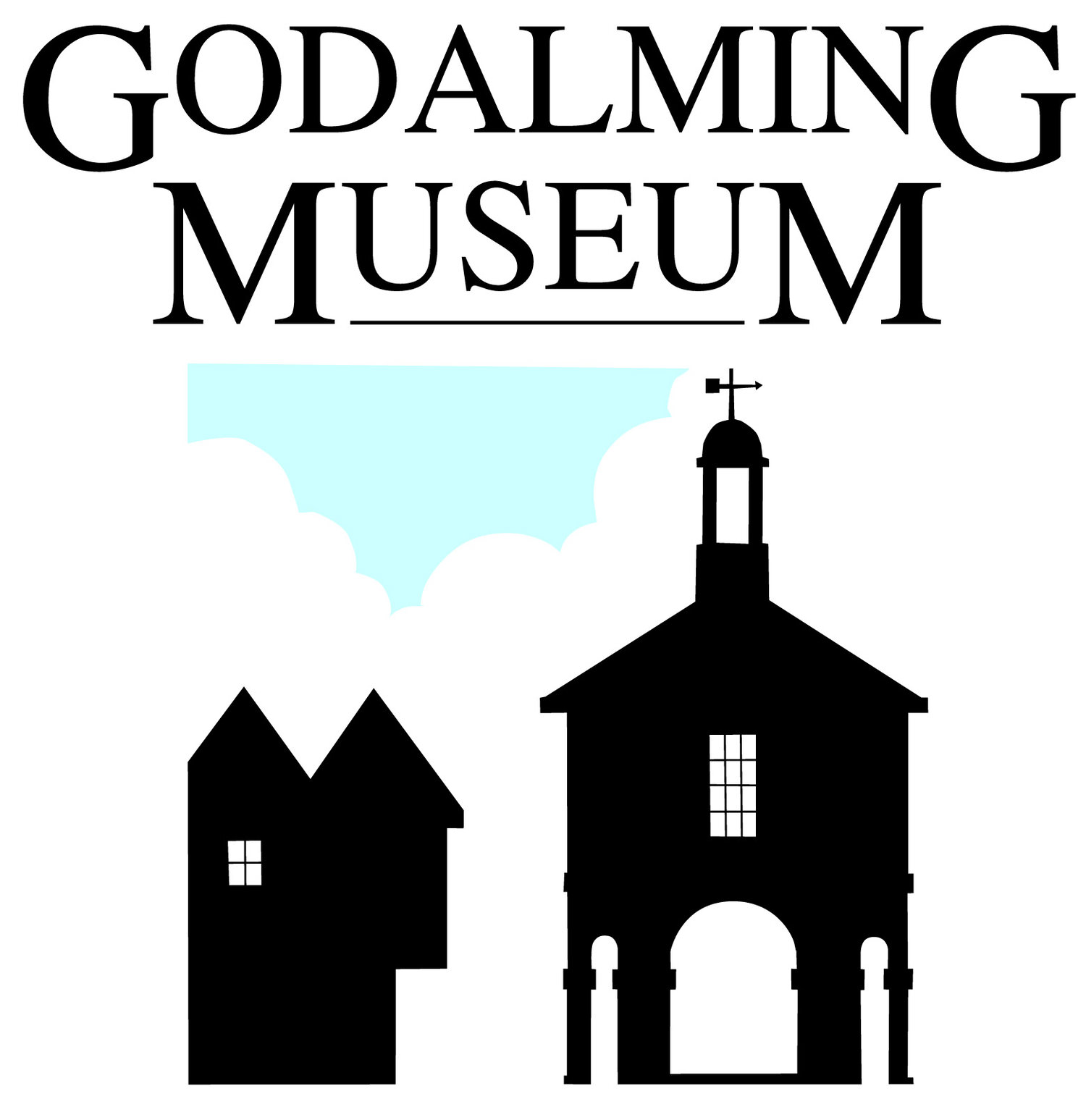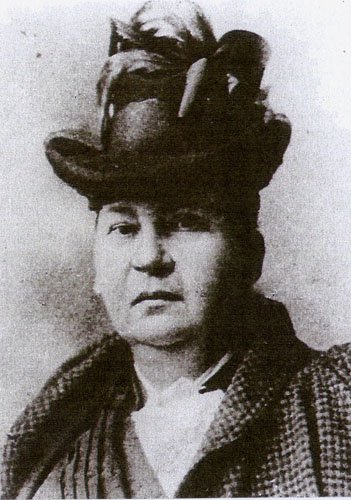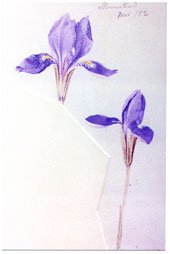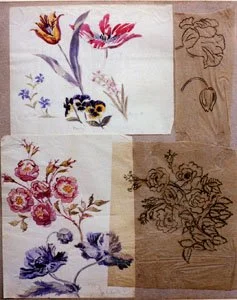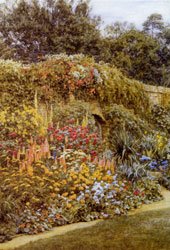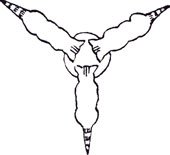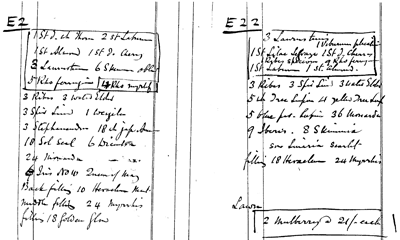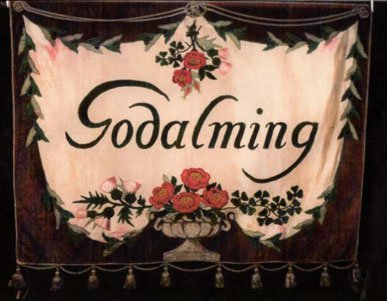Gertrude Jekyll (1843-1932)
Gertrude Jekyll , c.1880
image from Gertrude Jekyll A Memoir, 1934 by Francis Jekyll
In 1848, the Jekyll family (Gertrude was the fifth of seven children) came to Bramley where they lived for 20 years. In 1861 Jekyll went to the South Kensington School of Art, studying the writings of Ruskin and the paintings of Turner. She painted her cat, Thomas, at the age of 26.
Thomas in the Character of 'Puss-in Boots'
Oil painting by Gertrude Jekyll, 1869
(Godalming Museum Collection)
She travelled widely always noticing the plants, landscapes and customs, painting in watercolours and oil. This oil picture was one she painted after the style of Turner c.1870.
The Sun of Venice Going to Sea
Oil painting by Gertrude Jekyll
(Godalming Museum Collection)
Her circle of friends was wide and influential including John Ruskin, William Morris, G F Watts (who came to live at Compton) and Hercules Brabazon Brabazon – watercolour artist whose experiments with colour profoundly influenced her.
The family moved to Wargrave, Berkshire, but returned to Surrey to live at Munstead in 1878. Jekyll and her widowed mother moved to a newly built house, and it was here that she found her love of creating gardens. In 1882 her mother gave her some land across the road, which she had bought, and which she hoped would be a home for her daughter after her death. From her childhood, plants and flowers and their relationship with each other fascinated Jekyll, and she loved to explore the lanes, heaths and woods.
Iris Stylosa, Munstead 1882
Watercolour by Gertrude Jekyll
(Godalming Museum Collection)
She drew flowers in pencil (Almond Blossom), in pen and ink (Lesser Trumpet and Daffodil) as well as watercolour. Besides painting, drawing and sketching Gertrude Jekyll became interested in embroidery, designing for friends.
Tulips and roses can be seen on the tracings she made preparatory to embroidering (Godalming Museum Collection).
Jekyll learnt the country crafts, mastering thatching, fencing, walling, carpentry and metalworking, and became a designer craftswoman. She made herself proficient in carving, gilding and inlaying; working in silver decorated by embossing. Witley Church has a paten with a monogram and inscription commissioned from her in 1888, currently on display in the museum, as is a picture made of shells mounted on panelling from old pew seats taken out of Bramley Church.
She took up photography, which eventually enabled her to capture images when her eyes could no longer see clearly. Her extreme short-sightedness caused her to give up art and crafts, and further deterioration meant she concentrated on gardens.
In 1899 Jekyll was introduced to the young architect, Edwin Lutyens, by Harry Mangles of Littleworth near Seale, a pioneer rhododendron grower for whom Lutyens had designed a gardener’s cottage. She asked Lutyens to design a house for her in her garden. Jekyll and Lutyens explored the landscape and architecture of southwest Surrey in her pony cart. Lutyens designed Munstead Wood Hut in 1894 as a place where she could live until her own house was built. Her house, Munstead Wood, one of Lutyens’ early masterpieces, was begun in 1896.
Jekyll became increasingly involved in the gardens Lutyens was designing for his houses, advising him on the materials to be used and supplying detailed planting plans. An example of their work together is Orchards in Munstead built entirely of local material: other examples of the partnership are at Tigbourne Court, Witley, and Goddards in Abinger, where the Lutyens Trust is based.
The South Border at Munstead Wood,
by Helen Allingham (Godalming Museum Collection)
She took an interest in disappearing country crafts, which led to her collecting old household implements and recording their use. Her book Old West Surrey includes her photographs of illustrations and the old crafts and cottages she had seen in her travels around Surrey.
Jekyll and Lutyens had the same sense of humour. Lutyens drew sketches - of Jekyll whom he affectionately called ‘Bumps’ – ‘the mother of all the bulbs’ referring to her figure. enjoyed sketching especially her cats, which were published in a chapter 'Pussies in the Garden' in her book Children and Gardens. Lutyens described her picture of three cats drinking from a bowl of milk as an “equicateral” triangle.
Jekyll’s reputation as a plantswoman and garden designer had been steadily growing. Her circle included William Robinson (author of the English Flower Garden), Revd. Reynolds Hole (who wrote A Book about Roses) and G F Wilson, owner of the gardens at Wisley.
Jekyll wrote many articles for magazines and newspapers such as Robinson’s periodical, The Garden, and Gardening Illustrated and Country Life. Her books, often illustrated by her own photographs and drawings, had a profound influence, direct or indirect, on garden design through the British Isles, in France, and particularly in the United States. Her books were concerned with garden ornaments and flower decoration in the home as well as the principles of planting, colour grouping and garden design. Everything was based on her own experience and showed meticulous attention to detail.
Jekyll’s Garden Drawings and Correspondence
Her drawings give some insight into how she carefully planned her gardens. They are listed under house name of the garden, and also under various types of planting schemes e.g. peony borders, kitchen gardens, herb gardens, spring planting. Letters between clients and Jekyll survive.
Jekyll’s Notebooks
Plants often came from her nurseries at Munstead Wood. Her original planting notebooks include detailed lists of plants for particular gardens.
There are three collections in the Godalming Museum Local Studies Library.
1. The Gertrude Collection of Garden Drawings (Gertrude Jekyll Collection (1955-1), Environmental Design Archives, University of California, Berkeley)
2. Correspondence between Gertrude Jekyll and Clients (Gertrude Jekyll Collection (1955-1), Environmental Design Archives, University of California, Berkeley)
3. Original Plant List Notebooks (Godalming Museum)
Locally Jekyll was prominent in the campaign to save the Old Town Hall in Godalming from demolition. She designed the garden for the Jack Phillips Memorial Cloister in Godalming, and supervised the transformation of Hydon Heath into an accessible public memorial for Octavia Hill, one of the founders of the National Trust.
She took an interest in female suffrage, creating an embroidered banner for the Godalming Branch of the National Union of Women’s Suffrage Societies (NUWSS). A photograph shows the banner being paraded on a Suffrage Pilgrimage through Guildford in July 1913
Godalming Women's Suffrage Society Banner
(Godalming Museum Collection)
In the Arts and Crafts Gallery at Godalming Museum one can see her personal memorabilia, including a garden fork and shears, Gladstone bag, travelling desk and gardening boots (kindly lent by Guildford Museum).
Her tombstone in Busbridge Churchyard, designed by Lutyens, is inscribed:
